Cell-size dependent progression of the cell cycle for homeostasis and flexibility of cell size
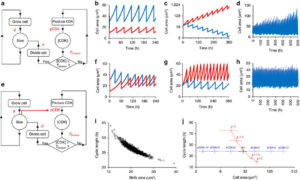 Cell size is determined by growth rate and frequency of division. Studies in yeast revealed mechanisms that coordinate these processes, as well as the crucial checkpoint controls that ensure the cell is “ready” to divide, but can models from single-celled organisms be applied to multicellular ones that have intrinsic differences including mechanical constraints? Jones et al. investigate the linkage between growth and division in the shoot apical meristem. Through imaging, modeling and mutant analysis, they show that the size of the call at birth is correlated with the length of time to division, which serves to normalize variations in cell size. They also found that the cell cycle length is determined by the activity of cyclin-dependent kinase (CDK), that the lengths of the G1 phase and the S-G2-M phase are size dependent, and that cell size is dependent on metabolic status. Overall, they conclude that cell size control regulation is similar in Arabidopsis and yeast. Nature Comms. 10.1038/ncomms15060
Cell size is determined by growth rate and frequency of division. Studies in yeast revealed mechanisms that coordinate these processes, as well as the crucial checkpoint controls that ensure the cell is “ready” to divide, but can models from single-celled organisms be applied to multicellular ones that have intrinsic differences including mechanical constraints? Jones et al. investigate the linkage between growth and division in the shoot apical meristem. Through imaging, modeling and mutant analysis, they show that the size of the call at birth is correlated with the length of time to division, which serves to normalize variations in cell size. They also found that the cell cycle length is determined by the activity of cyclin-dependent kinase (CDK), that the lengths of the G1 phase and the S-G2-M phase are size dependent, and that cell size is dependent on metabolic status. Overall, they conclude that cell size control regulation is similar in Arabidopsis and yeast. Nature Comms. 10.1038/ncomms15060


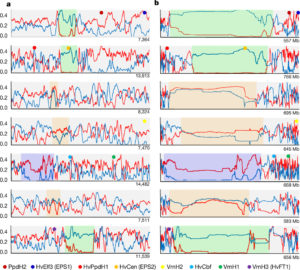 Cereal grasses are of course economically important, but they also have large repetitive genomes with large pericentromeric regions that have been difficult to map and sequence. Barley (Hordeum vulgare L.) is used for human and animal food and fermented to produce beer and whisky. A barley sequence assembly was published in 2012, but now Mascher et al. have used chromosome conformation capture mapping to produce a much more complete barley genome sequence, including sequences across the pericentromeric region. Their data reveal significant differences in gene density, recombination rates and retrotransposon distribution in the distal versus proximal regions of the chromosome. They also observe low levels of variation within elite germplasms, presumably due to intense selection. Nature
Cereal grasses are of course economically important, but they also have large repetitive genomes with large pericentromeric regions that have been difficult to map and sequence. Barley (Hordeum vulgare L.) is used for human and animal food and fermented to produce beer and whisky. A barley sequence assembly was published in 2012, but now Mascher et al. have used chromosome conformation capture mapping to produce a much more complete barley genome sequence, including sequences across the pericentromeric region. Their data reveal significant differences in gene density, recombination rates and retrotransposon distribution in the distal versus proximal regions of the chromosome. They also observe low levels of variation within elite germplasms, presumably due to intense selection. Nature 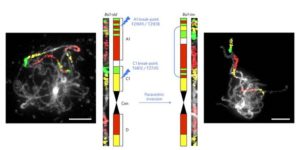 Chromosomal inversions are chromosomal rearrangements that can span several Mb and have been described in several organisms from Drosophila to maize. Inversions suppress recombination and can favor local adaptation and speciation if they capture favorable alleles. It’s not clear though if favorable alleles accumulate in older inversions or, as the Kirkpatrick–Barton model proposes, inversions capture chromosomal blocks that contain pre-existing adaptive alleles. Lee et al. show that in a hybrid speciation zone with ecologically different subspecies (East and West) of Boechera stricta (a wild-growing brassica) a young inversion arose after the last glaciation, quickly reached high frequency and shows signs of positive selection. The authors used a cross of collinear haplotypes to show that the inversion carries several QTLs that influence several phenological and developmental traits and controls high percentages of the phenological differences between the two subspecies. In summary this paper shows that inversions can capture pre-existing, favorable, linked QTLs during initial steps of speciation. (Summary by
Chromosomal inversions are chromosomal rearrangements that can span several Mb and have been described in several organisms from Drosophila to maize. Inversions suppress recombination and can favor local adaptation and speciation if they capture favorable alleles. It’s not clear though if favorable alleles accumulate in older inversions or, as the Kirkpatrick–Barton model proposes, inversions capture chromosomal blocks that contain pre-existing adaptive alleles. Lee et al. show that in a hybrid speciation zone with ecologically different subspecies (East and West) of Boechera stricta (a wild-growing brassica) a young inversion arose after the last glaciation, quickly reached high frequency and shows signs of positive selection. The authors used a cross of collinear haplotypes to show that the inversion carries several QTLs that influence several phenological and developmental traits and controls high percentages of the phenological differences between the two subspecies. In summary this paper shows that inversions can capture pre-existing, favorable, linked QTLs during initial steps of speciation. (Summary by 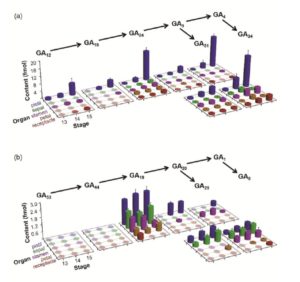 We all learned the series milli-, micro-, nano-, pico-, femto-, but I didn’t learn atto- (10-18), as it’s rarely used in biology, representing such a tiny number (FYI, atto- is followed by zepto- and yocto-). Li et al provide a method for quantifying gibberellin (GA) hormones at “near attomole” amounts from a single Arabidopsis flower. Any molecule is hard to isolate in attomolar amounts, but gibberellins provide a particular challenge as they are a family of closely-related compounds that are difficult to separate. By reacting the GAs with a positively-charged moiety [N-(3-dimethylaminopropyl)-N’-ethylcarbodiimide (EDC)] in ethanol, the authors were able to use an ultra-high-performance liquid chromatography (UHPLC)-ESI-MS/MS method to detect tiny amounts of different GAs from the dissected organs of a single Arabidopsis flower. Plant J.
We all learned the series milli-, micro-, nano-, pico-, femto-, but I didn’t learn atto- (10-18), as it’s rarely used in biology, representing such a tiny number (FYI, atto- is followed by zepto- and yocto-). Li et al provide a method for quantifying gibberellin (GA) hormones at “near attomole” amounts from a single Arabidopsis flower. Any molecule is hard to isolate in attomolar amounts, but gibberellins provide a particular challenge as they are a family of closely-related compounds that are difficult to separate. By reacting the GAs with a positively-charged moiety [N-(3-dimethylaminopropyl)-N’-ethylcarbodiimide (EDC)] in ethanol, the authors were able to use an ultra-high-performance liquid chromatography (UHPLC)-ESI-MS/MS method to detect tiny amounts of different GAs from the dissected organs of a single Arabidopsis flower. Plant J.  A pair of Breakthrough Technology papers in Plant Physiology discusses new tools to identify hydroxyproline-rich glycoproteins and insights into their evolution. Hydroxyproline-rich glycoproteins (HRGPs) are repeat-rich cell wall proteins that have been described as falling into three large families: arabinogalactan-proteins (AGPs), extensins (EXTs), and proline-rich proteins (PRPs). In the first paper (
A pair of Breakthrough Technology papers in Plant Physiology discusses new tools to identify hydroxyproline-rich glycoproteins and insights into their evolution. Hydroxyproline-rich glycoproteins (HRGPs) are repeat-rich cell wall proteins that have been described as falling into three large families: arabinogalactan-proteins (AGPs), extensins (EXTs), and proline-rich proteins (PRPs). In the first paper ( Environmental changes affect the biodiversity (variety of life forms) and productivity (conversion of sunlight energy and carbon into plant biomass) of ecological communities. The collaborative Nutrient Network (NutNet) was created 10 years ago with the goal of synthesizing studies of ecosystem environmental responses (mainly of grasslands) and tackling their shortcomings. This review by Borer et al. summarizes the results of this global experiment with over 100 study sites from all over the world, focusing on advances in productivity-diversity relationships, and interactive effects of multiple nutrients, nutrient supply and herbivory. NutNet data have shown that variation in environmental factors (climate, soil fertility, herbivory and light) explains most of the variation in plant diversity within and among grasslands, more than productivity alone. Further, variation in the balance of many nutrients, not only N and P, influences diversity. Specifically, there is a decline in species richness in fertilized or more productive plots, as well as an increase in dominance of exotic species and loss of natives. However, this latter effect can be overcome by the presence of vertebrate herbivores, as grazing increases diversity which favors native flowering plants. Fortunately for us, NutNet’s dataset keeps growing, and our capacity to understand ecosystem dynamics in response to climate change grows along with it. “A decade of NutNet research has demonstrated that a multi-continental, distributed, experimental approach, if designed well, can be a sustainable approach for generating high-quality, large-scale, long-term ecological datasets.” (Summary by
Environmental changes affect the biodiversity (variety of life forms) and productivity (conversion of sunlight energy and carbon into plant biomass) of ecological communities. The collaborative Nutrient Network (NutNet) was created 10 years ago with the goal of synthesizing studies of ecosystem environmental responses (mainly of grasslands) and tackling their shortcomings. This review by Borer et al. summarizes the results of this global experiment with over 100 study sites from all over the world, focusing on advances in productivity-diversity relationships, and interactive effects of multiple nutrients, nutrient supply and herbivory. NutNet data have shown that variation in environmental factors (climate, soil fertility, herbivory and light) explains most of the variation in plant diversity within and among grasslands, more than productivity alone. Further, variation in the balance of many nutrients, not only N and P, influences diversity. Specifically, there is a decline in species richness in fertilized or more productive plots, as well as an increase in dominance of exotic species and loss of natives. However, this latter effect can be overcome by the presence of vertebrate herbivores, as grazing increases diversity which favors native flowering plants. Fortunately for us, NutNet’s dataset keeps growing, and our capacity to understand ecosystem dynamics in response to climate change grows along with it. “A decade of NutNet research has demonstrated that a multi-continental, distributed, experimental approach, if designed well, can be a sustainable approach for generating high-quality, large-scale, long-term ecological datasets.” (Summary by 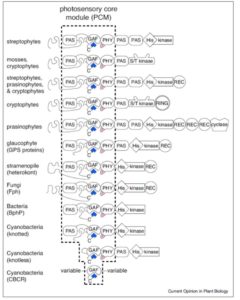 Phytochromes were first characterized in classic studies of plants, in which their contributions to seed germination and initiation of flowering were described. Subsequently, phytochromes were identified in cyanobacteria and in non-photosynthetic organisms including fungi. Rockwell and Lagarias review the structure and function of phytochromes in diverse organisms, describe current models for the origin of plant phytochromes, and summarize unanswered questions. Curr. Opin. Plant Biol.
Phytochromes were first characterized in classic studies of plants, in which their contributions to seed germination and initiation of flowering were described. Subsequently, phytochromes were identified in cyanobacteria and in non-photosynthetic organisms including fungi. Rockwell and Lagarias review the structure and function of phytochromes in diverse organisms, describe current models for the origin of plant phytochromes, and summarize unanswered questions. Curr. Opin. Plant Biol. 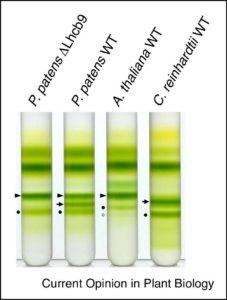 The ancestors of land plants were aquatic. Myriad changes accompanied the transition from aquatic to terrestrial life, including changes necessitated by the difference in light intensity and quality. Bryophytes, the earliest diverging land plants, have some characteristics that reveal how plants transitioned from aquatic algae. The moss Physcomitrella patens has become a model for the bryophytes, with a sequenced genome and many genetic tools available. Iwai and Yokono review the moss light-harvesting complex (Lhc) proteins, which are more diverse than those of the angiosperm Arabidopsis or the alga Chlamydomonas, and appear to facilitate additional photoprotection and electron transport pathways. Curr. Opin. Plant Biol.
The ancestors of land plants were aquatic. Myriad changes accompanied the transition from aquatic to terrestrial life, including changes necessitated by the difference in light intensity and quality. Bryophytes, the earliest diverging land plants, have some characteristics that reveal how plants transitioned from aquatic algae. The moss Physcomitrella patens has become a model for the bryophytes, with a sequenced genome and many genetic tools available. Iwai and Yokono review the moss light-harvesting complex (Lhc) proteins, which are more diverse than those of the angiosperm Arabidopsis or the alga Chlamydomonas, and appear to facilitate additional photoprotection and electron transport pathways. Curr. Opin. Plant Biol. 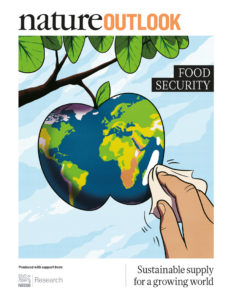 Nature has published an
Nature has published an